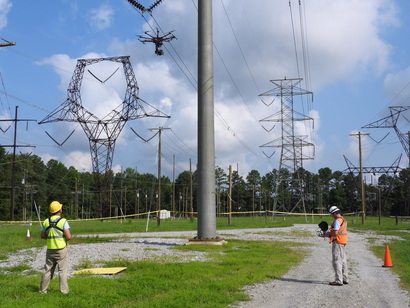Power Line Inspections the Drone Way
Inspecting high-voltage electrical lines, cell towers and suspension bridges can be hazardous undertakings when humans have to climb to dizzying heights to get up close. Inspecting at a distance from a helicopter is a potentially safer alternative, but helicopters are expensive, provide limited visibility and have their own public safety issues.
With help from HAZON Solutions LLC (HAZON), a Virginia-based, veteran-owned service provider of unmanned aerial vehicle (UAV) platform inspection systems for infrastructure organizations, and UAV-America, a designer and integrator of UAVs (aka drones), Dominion Virginia Power has been testing a novel new solution that promises to be both safer than inspections using personnel and more effective than helicopter inspections.
“If a UAV can take on the initial inspection that helps the customer discover the location and nature of any faults, then human beings can be deployed only in the much rarer instances when a repair must be done,” says Sean Cushing, president and co-founder of HAZON Solutions “This improves the safety not only of the inspectors but for the public, as drone inspections can be done more frequently and effectively.”
Drones can also help prepare for and react to natural disasters. “They can help customers identify vulnerabilities, conduct post damage assessment and direct resources efficiently,” says Cushing. HAZON’s partnership with UAV-America has helped it deliver robust drone and sensor solutions for a host of different infrastructure inspection scenarios. “We work very closely with HAZON to design, build and test the best drone and sensor solutions for their specific requirements,” says UAV-America’s president, Jim Cooper.
HAZON first approached Dominion Virginia Power to help the company acquire the expertise and experience to fulfill the FAA certificate of authorization (COA) process. Immediately, Dominion saw the value of a drone approach to inspecting high-voltage power lines. “We worked with Dominion at its test sites to develop, perfect and validate our procedures,” says Cushing. “It was a mutual partnership that helped us all understand exactly how drones could be used.”
HAZON needed a platform that could take high-quality videos and photos and could zoom in from a distance. “We couldn’t get too close to the wires and we knew that stability would be important under windy conditions.” UAV-America provided a highly stable multirotor platform with cameras capable of extreme close-ups. HAZON went to UAV-America’s location to tweak, test and train with UAV instructors in a safe environment. Then it deployed the solution at the Dominion test site, which it has been doing for the past eight months, comparing its results with those of standard helicopter inspections.
The results? According to HAZON, the multirotor and camera solution can capture up to 50 percent more information than a helicopter with a pilot and two observers. “They can’t get as close as we can or get underneath the lines,” says Cushing. Everyone has been wowed by the imagery. “The drone images let us read nameplate data of assets 150 feet up in the air and detect tiny chips or cracks in insulators,” says Steve Eisenrauch, Dominion Virginia Manager of Transmission Forestry and Lines Services. The cost also promises to be considerably lower than deploying a helicopter and three pilots and inspectors.
HAZON has found its partnership with UAV-America critical to its success. “We can call them up, talk about new ideas, concepts and requirements, such as new cameras, and they’ll test them immediately at their location to see if they would work well with our setup.”
In all, drone inspections are safer and potentially less expensive than the alternatives, making them a win-win all around. “I can envision a time in the not too distant future when a lineman will carry a small drone in his or her pocket that beams high resolution images back via a smart phone,” says Eisenrauch, “and then, thanks to UAV’s, we can do inspections once a month or once a week rather than once a year.”
Inspecting high-voltage electrical lines, cell towers and suspension bridges can be hazardous undertakings when humans have to climb to dizzying heights to get up close. Inspecting at a distance from a helicopter is a potentially safer alternative, but helicopters are expensive, provide limited visibility and have their own public safety issues.
With help from HAZON Solutions LLC (HAZON), a Virginia-based, veteran-owned service provider of unmanned aerial vehicle (UAV) platform inspection systems for infrastructure organizations, and UAV-America, a designer and integrator of UAVs (aka drones), Dominion Virginia Power has been testing a novel new solution that promises to be both safer than inspections using personnel and more effective than helicopter inspections.
“If a UAV can take on the initial inspection that helps the customer discover the location and nature of any faults, then human beings can be deployed only in the much rarer instances when a repair must be done,” says Sean Cushing, president and co-founder of HAZON Solutions “This improves the safety not only of the inspectors but for the public, as drone inspections can be done more frequently and effectively.”
Drones can also help prepare for and react to natural disasters. “They can help customers identify vulnerabilities, conduct post damage assessment and direct resources efficiently,” says Cushing. HAZON’s partnership with UAV-America has helped it deliver robust drone and sensor solutions for a host of different infrastructure inspection scenarios. “We work very closely with HAZON to design, build and test the best drone and sensor solutions for their specific requirements,” says UAV-America’s president, Jim Cooper.
HAZON first approached Dominion Virginia Power to help the company acquire the expertise and experience to fulfill the FAA certificate of authorization (COA) process. Immediately, Dominion saw the value of a drone approach to inspecting high-voltage power lines. “We worked with Dominion at its test sites to develop, perfect and validate our procedures,” says Cushing. “It was a mutual partnership that helped us all understand exactly how drones could be used.”
HAZON needed a platform that could take high-quality videos and photos and could zoom in from a distance. “We couldn’t get too close to the wires and we knew that stability would be important under windy conditions.” UAV-America provided a highly stable multirotor platform with cameras capable of extreme close-ups. HAZON went to UAV-America’s location to tweak, test and train with UAV instructors in a safe environment. Then it deployed the solution at the Dominion test site, which it has been doing for the past eight months, comparing its results with those of standard helicopter inspections.
The results? According to HAZON, the multirotor and camera solution can capture up to 50 percent more information than a helicopter with a pilot and two observers. “They can’t get as close as we can or get underneath the lines,” says Cushing. Everyone has been wowed by the imagery. “The drone images let us read nameplate data of assets 150 feet up in the air and detect tiny chips or cracks in insulators,” says Steve Eisenrauch, Dominion Virginia Manager of Transmission Forestry and Lines Services. The cost also promises to be considerably lower than deploying a helicopter and three pilots and inspectors.
HAZON has found its partnership with UAV-America critical to its success. “We can call them up, talk about new ideas, concepts and requirements, such as new cameras, and they’ll test them immediately at their location to see if they would work well with our setup.”
In all, drone inspections are safer and potentially less expensive than the alternatives, making them a win-win all around. “I can envision a time in the not too distant future when a lineman will carry a small drone in his or her pocket that beams high resolution images back via a smart phone,” says Eisenrauch, “and then, thanks to UAV’s, we can do inspections once a month or once a week rather than once a year.”

